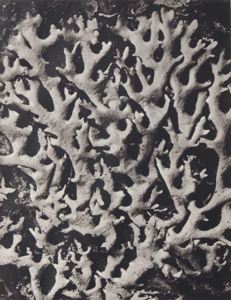Karl Blossfeldt
(Schielo, Germany, 1865 - 1932, Berlin, Germany)
Parmelia conspersa. Parmelia, lichen, enlarged 11 times
From the series "Wundegarten Der Natur (Magic Garden of Nature)"
1932
Photogravure
11 x 8 1/2 in. (27.9 x 21.6 cm)
Collection of the Akron Art Museum
Museum Acquisition Fund
1979.27.68
More Information
June, 2017 Serial Intent Liz Carney Karl Blossfeldt started taking photographs in 1898 when he began teaching a course in sculpting from living plants at a Berlin university. The camera allowed Blossfeldt to bring attention to miniscule details, which he enlarged well over life-size to create surprising and aesthetically pleasing textured compositions. Though Blossfeldt created thousands of photographs over decades of teaching, he didn’t publish them as art until the late 1920s. The majority of the plants pictured in his second book, Wundergarten Der Natur, are common varieties—many are considered weeds—but each photograph elevates its subject. Within the repetition of Blossfeldt’s rigorous, objective method, their unique qualities emerge, even as the images retain a botanical-scientific quality that reflects their origin as didactic material.
Keywords
SurrealBlack and White
Texture
Photography
Magnification
Plants
Germany

